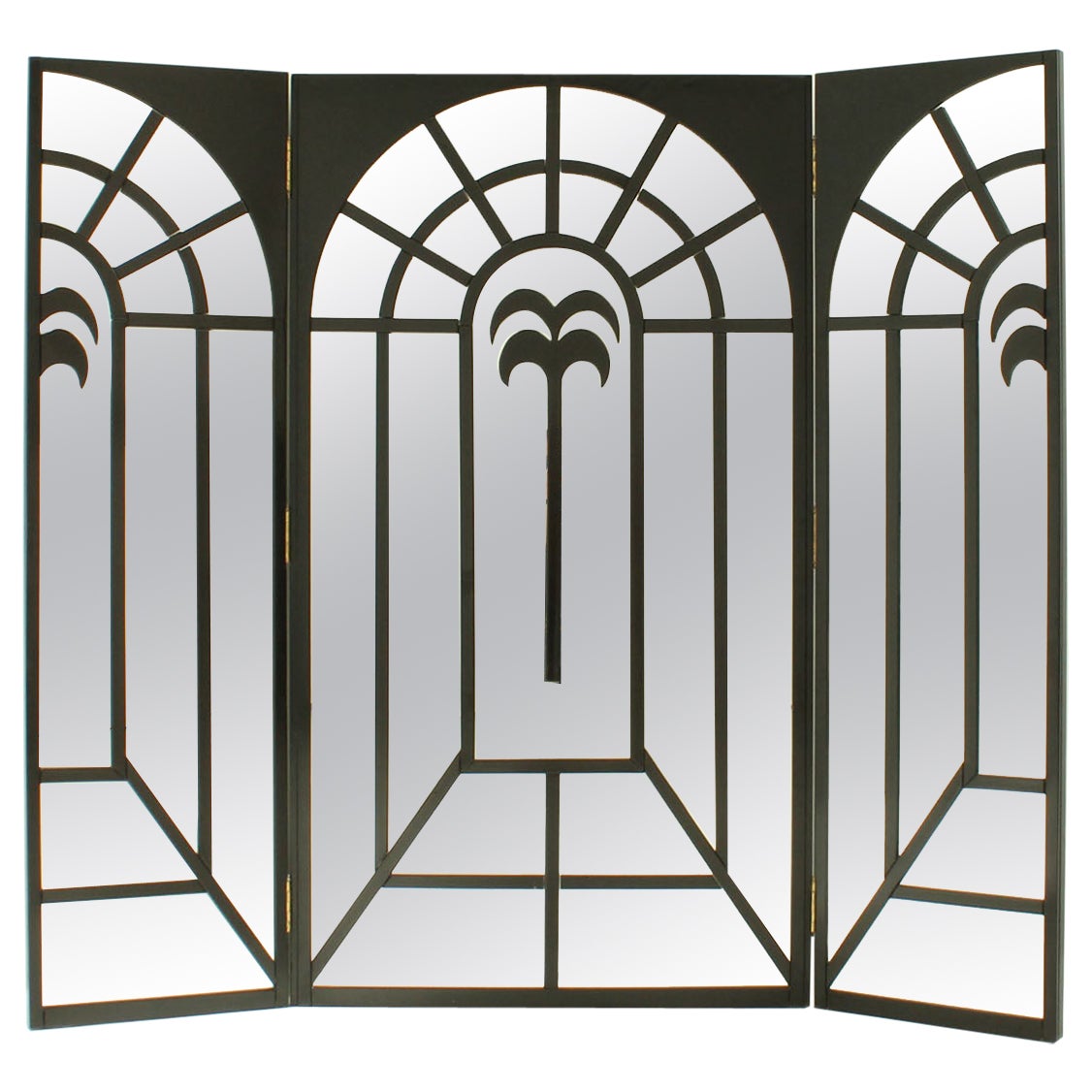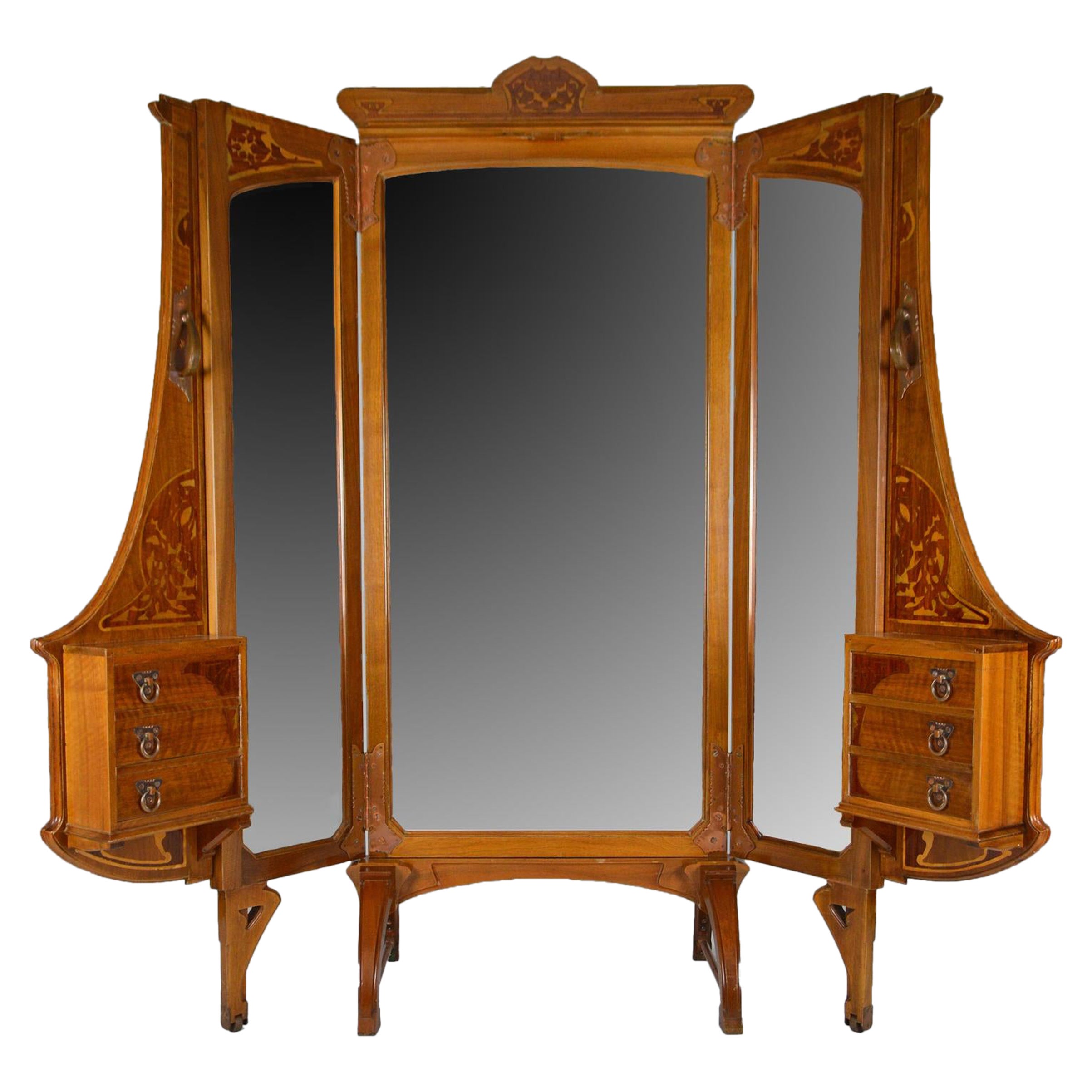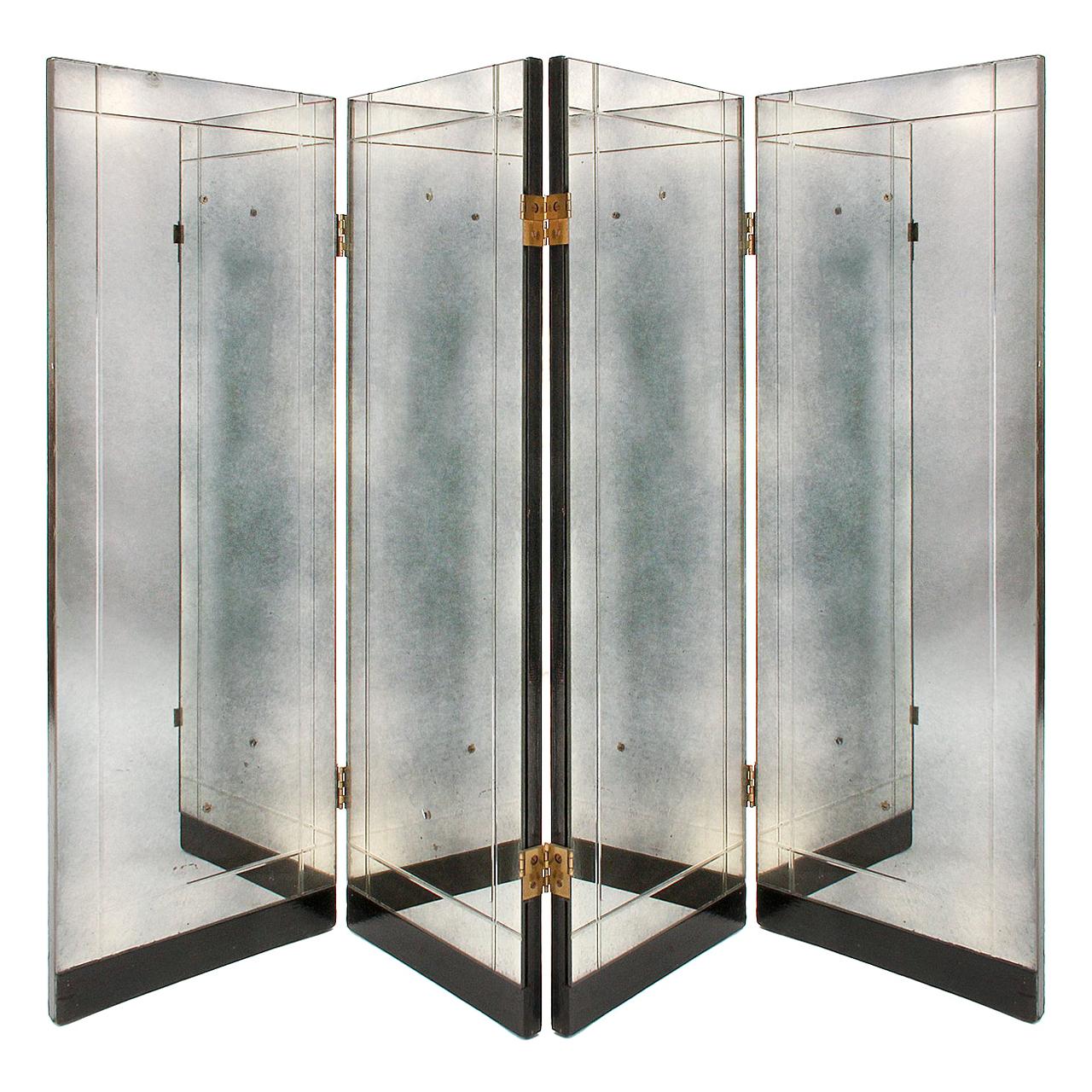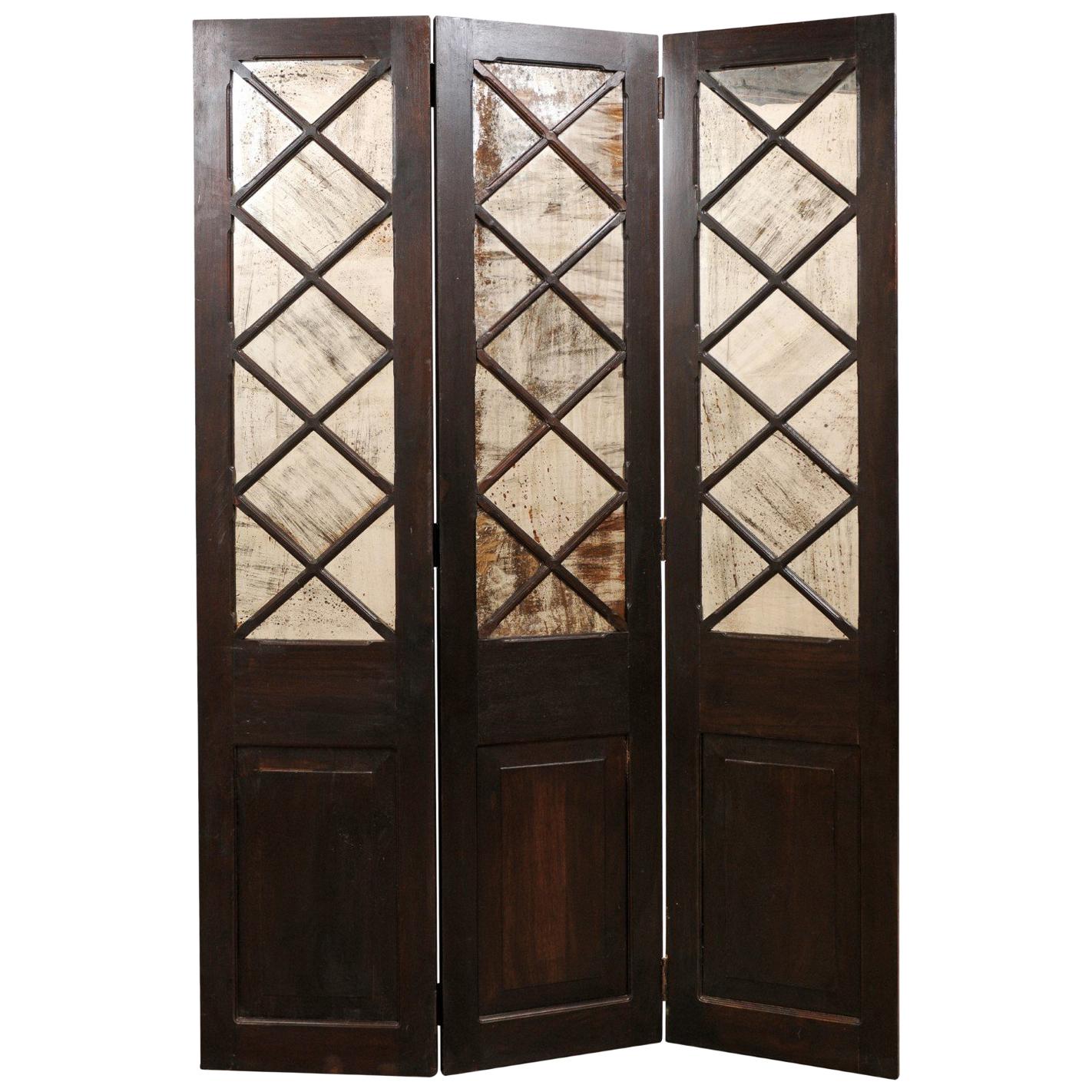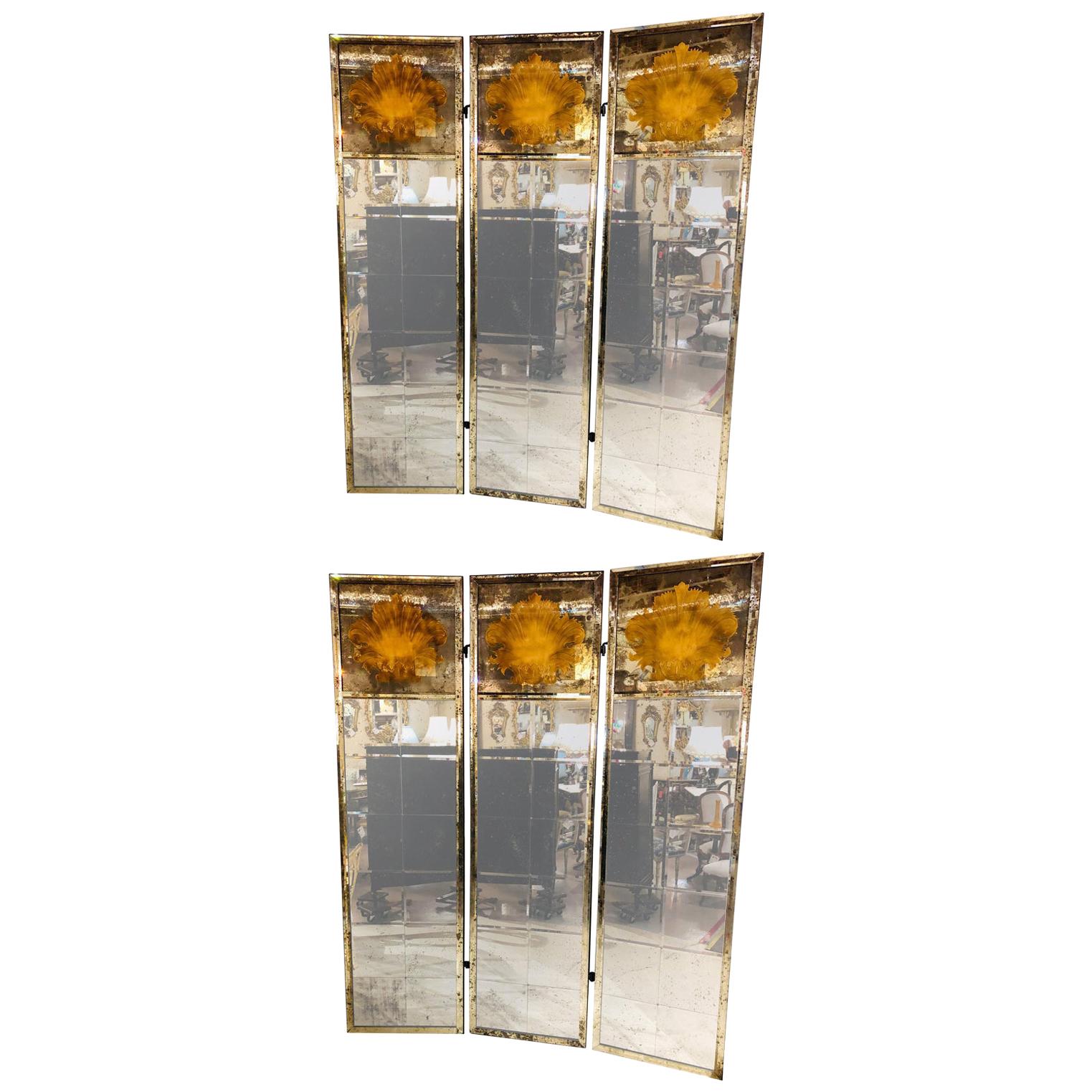Items Similar to 20th Century Italian Folding Mirror Screen 'Parma Series' Vivai Del Sud, c.1970
Want more images or videos?
Request additional images or videos from the seller
1 of 11
20th Century Italian Folding Mirror Screen 'Parma Series' Vivai Del Sud, c.1970
About the Item
Striking 20th Century Italian mirrored screen from the 'Parma' series, by Vivai del Sud bamboo. This exquisite screen consists of bamboo palm tree motif inlay on a 3-panel mirrored screen. In the spirit of Vivai del Sud, the use of trompe l'oeil creates an atmosphere of an oasis created by a presence of palm trees. Vivai del Sud was established in the early 1950 and during the 1970's established itself as a leader in the field of high-end furniture and accessories for indoor and outdoor use, this is a real conversation piece and a superb piece of history reminiscent of the bygone eras.
- Creator:Vivai del Sud (Maker)
- Dimensions:Height: 72.05 in (183 cm)Width: 78.75 in (200 cm)Depth: 3.94 in (10 cm)
- Materials and Techniques:
- Place of Origin:
- Period:
- Date of Manufacture:circa 1970
- Condition:Wear consistent with age and use. Minor fading. In Good Condition - wear consistent with age.
- Seller Location:Royal Tunbridge Wells, GB
- Reference Number:
About the Seller
5.0
Platinum Seller
These expertly vetted sellers are 1stDibs' most experienced sellers and are rated highest by our customers.
Established in 2014
1stDibs seller since 2015
371 sales on 1stDibs
Typical response time: <1 hour
- ShippingRetrieving quote...Ships From: Sherring, United Kingdom
- Return PolicyA return for this item may be initiated within 14 days of delivery.
More From This SellerView All
- 20th Century Italian Folding Mirror Screen 'Parma Series' Vivai del Sud, c.1970By Vivai del SudLocated in Royal Tunbridge Wells, KentAn extremely stylish bamboo room divider (or screen) manufactured by Vivai Del Sud in Italy in the 1970s. This mid century mirrored bifold screen is a statement piece which is part of Maurizio Mariani...Category
20th Century Italian Floor Mirrors and Full-Length Mirrors
MaterialsBamboo, Glass
- 20th Century Italian Bamboo Arc Floor Lamp by Vivai del Sud, circa 1970By Vivai del SudLocated in Royal Tunbridge Wells, KentAn unusual mid 20th century Italian made bamboo arc light designed by Vivai Del Sud. Created in the iconic 1970's. Combining the opulence of Italian Baroq...Category
20th Century Italian Floor Lamps
MaterialsMetal
- 20th Century Oil Painted On Leather Room Screen, c.1920Located in Royal Tunbridge Wells, KentAntique 20th Century beautifully painted four panel dress screen depicting 17th Century battleships at sea. Painted oil on leather, each panel is finished...Category
20th Century European Screens and Room Dividers
MaterialsLeather, Paint
- 20th Century Louis Vuitton Suitcase In Monogram Canvas, France c.1970By Louis VuittonLocated in Royal Tunbridge Wells, KentA delightful mid to late 20th-century Louis Vuitton hard-sided case, covered with the iconic monogram canvas and complemented by brass fittings. The exterior exudes the unmistakable ...Category
Vintage 1970s French Other Trunks and Luggage
MaterialsLeather, Canvas
- 20th Century Louis Vuitton Trunk, France c.1930By Louis VuittonLocated in Royal Tunbridge Wells, KentAn exquisite and complete Louis Vuitton trunk from the early part of the 20th century. An absolutely essential item for elite travellers of its time the trunk is adorned in the iconic LV monogrammed canvas, accented by lozine trim and brass fittings. This trunk stood as the epitome of luxury over 100 years ago, boasting an unparalleled level of sophistication and elegance, it remains a timeless masterpiece that transcends eras. The captivating allure of the Louis Vuitton trunk transforms it into more than a mere luggage accessory; it becomes a focal point for any room. With its impressive dimensions, it is perfectly suited as a striking coffee table, side table, or even as a standalone centrepiece, seamlessly integrating into any interior, whether modern or traditional. An extraordinary piece that not only pays homage to the past but also serves as a statement of unparalleled luxury in the present. A brief history about Louis Vuitton trunks: Louis Vuitton was born in 1821 to a farmer and milliner and came from a long-established working-class family in eastern France. Vuitton grew up understanding the effects of perseverance and a strong work ethic from watching his family. At the age of 16, he made the decision to walk 292 miles from his hometown to Paris to try and make a new life for himself. When he arrived the city was in the midst of industrialization with current modes of transportation evolving quickly allowing for longer journeys. With this came the need for sturdy travel pieces. Vuitton was taken as an apprentice for a successful box maker and packer named Monsieur Marechal. He learned to craft durable containers and how to pack them properly – a well-respected profession at the time.In 1854, years after he had mastered his craft and became well respected for it, Vuitton ventured out on his own to open a shop on Rue Neuve des Capucines. It was here that he began to establish himself as a luggage maker. Then, in 1858, Vuitton designed the first Louis Vuitton steamer trunk. At the time trunks had rounded tops to allow for water to run off but this did not allow for convenient stowage. Vuitton introduced a flat, yet waterproof, trunk that was easily stackable. The first of his trunks were outfitted with a grey canvas referred to as Trianon – it wouldn’t be until several decades later that the signature monogram would be introduced. With a burgeoning business, Vuitton moved his family and workplace to Asniere, where he employed twenty workers to craft his trunks. By 1900 he would have 100 employees, and in 1914 the company would more than double in size. After years of success, Vuitton began to experiment with the design of his luggage by introducing a new striped canvas pattern (1876) and later the still well-known Damier print (1888). The hand-painted patterns were developed to prevent counterfeits. Even in the late 1800s, Louis Vuitton was enough of a status symbol to warrant counterfeiting. In 1886, his son George invented and patented an ingenious locking system that made it impossible to pick the lock of their trunks. This lock is still used today. 1892 would prove to be a time of mourning for the family as Louis Vuitton passed...Category
20th Century French Other Trunks and Luggage
MaterialsBrass
- 20th Century Louis Vuitton Trunk, France c.1910By Louis VuittonLocated in Royal Tunbridge Wells, KentAn exquisite and complete Louis Vuitton trunk from the early part of the 20th century. An absolutely essential item for elite travellers of its time the trunk is adorned in the iconic LV monogrammed canvas, accented by lozine trim and brass fittings. This trunk stood as the epitome of luxury over 100 years ago, boasting an unparalleled level of sophistication and elegance, it remains a timeless masterpiece that transcends eras. The captivating allure of the Louis Vuitton trunk transforms it into more than a mere luggage accessory; it becomes a focal point for any room. With its impressive dimensions, it is perfectly suited as a striking coffee table, side table, or even as a standalone centrepiece, seamlessly integrating into any interior, whether modern or traditional. An extraordinary piece that not only pays homage to the past but also serves as a statement of unparalleled luxury in the present. A brief history about Louis Vuitton trunks: Louis Vuitton was born in 1821 to a farmer and milliner and came from a long-established working-class family in eastern France. Vuitton grew up understanding the effects of perseverance and a strong work ethic from watching his family. At the age of 16, he made the decision to walk 292 miles from his hometown to Paris to try and make a new life for himself. When he arrived the city was in the midst of industrialization with current modes of transportation evolving quickly allowing for longer journeys. With this came the need for sturdy travel pieces. Vuitton was taken as an apprentice for a successful box maker and packer named Monsieur Marechal. He learned to craft durable containers and how to pack them properly – a well-respected profession at the time.In 1854, years after he had mastered his craft and became well respected for it, Vuitton ventured out on his own to open a shop on Rue Neuve des Capucines. It was here that he began to establish himself as a luggage maker. Then, in 1858, Vuitton designed the first Louis Vuitton steamer trunk. At the time trunks had rounded tops to allow for water to run off but this did not allow for convenient stowage. Vuitton introduced a flat, yet waterproof, trunk that was easily stackable. The first of his trunks were outfitted with a grey canvas referred to as Trianon – it wouldn’t be until several decades later that the signature monogram would be introduced. With a burgeoning business, Vuitton moved his family and workplace to Asniere, where he employed twenty workers to craft his trunks. By 1900 he would have 100 employees, and in 1914 the company would more than double in size. After years of success, Vuitton began to experiment with the design of his luggage by introducing a new striped canvas pattern (1876) and later the still well-known Damier print (1888). The hand-painted patterns were developed to prevent counterfeits. Even in the late 1800s, Louis Vuitton was enough of a status symbol to warrant counterfeiting. In 1886, his son George invented and patented an ingenious locking system that made it impossible to pick the lock of their trunks. This lock is still used today. 1892 would prove to be a time of mourning for the family as Louis Vuitton passed...Category
20th Century French Other Trunks and Luggage
MaterialsBrass
You May Also Like
- Large Vivai del Sud Standing Mirror or Screen in Lacquered WoodBy Vivai del SudLocated in Barcelona, ESLarge screen or standing mirror by Vivai del Sud, Italy, 1970's. Rare version in black lacquered wood and mirror produced in late 1970's by this Rome based company.Category
Vintage 1970s Italian Modern Floor Mirrors and Full-Length Mirrors
MaterialsMirror, Wood
- Vivai del Sud Three Panel Bamboo Screen Palm Tree MotifBy Vivai del SudLocated in Brooklyn, NYItalian mid-century “Vivai Del Sud” Tri-Fold Bamboo Screen with inlaid palm motif. This screen is an open canvas, you can add mirrors, art or anything else you can think off. This sc...Category
Mid-20th Century Italian Mid-Century Modern Screens and Room Dividers
MaterialsBamboo
- Art Nouveau Vanity Folding Mirror Screen with Marquetry, 1901By Maison KriegerLocated in VÉZELAY, FRExceptional dressing / vanity polyptych folding screen (5 panels). Mahogany structure with inlays / marquetry of different essences with floral motifs. Copper handles, hinges and...Category
Antique Early 1900s French Art Nouveau Floor Mirrors and Full-Length Mir...
MaterialsCopper
- Low Mirrored ScreenLocated in Sagaponack, NYAn etched mirror folding room divider with brass hinges and painted black base. Measurements are as shown. Each panel is 14" W.Category
Vintage 1930s American Neoclassical Floor Mirrors and Full-Length Mirrors
MaterialsBrass
- Pair of Art Deco Fashioned Three-Panel Mirrored Room Dividers or Folding ScreensLocated in Stamford, CTMonumental pair of Art Deco fashioned three-panel mirrored room dividers or folding screens. These simply spectacular shell carved distressed mirr...Category
Late 20th Century Hollywood Regency Screens and Room Dividers
MaterialsMirror
- Gilt Mirrored Back Three-Panel Louis XVI Style Folding Screen Gilt Gold FinishLocated in Stamford, CTThree panel Louis XVI style folding screen or room separator. Gilt gold finish having six small mirrors above finely carved panels. Reverse is upholster...Category
Early 20th Century French Screens and Room Dividers
MaterialsMirror
